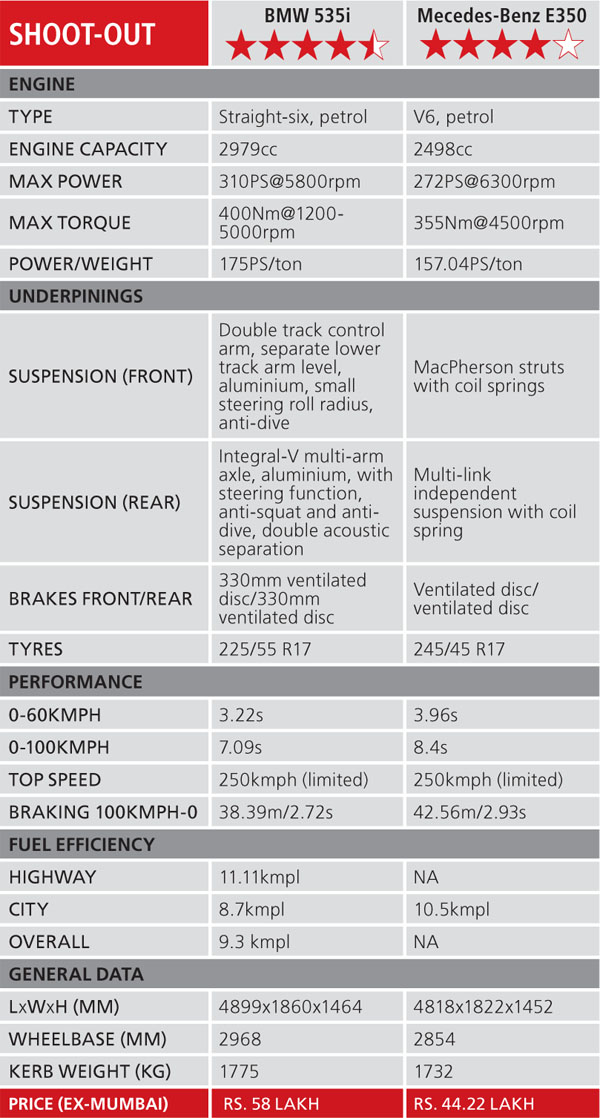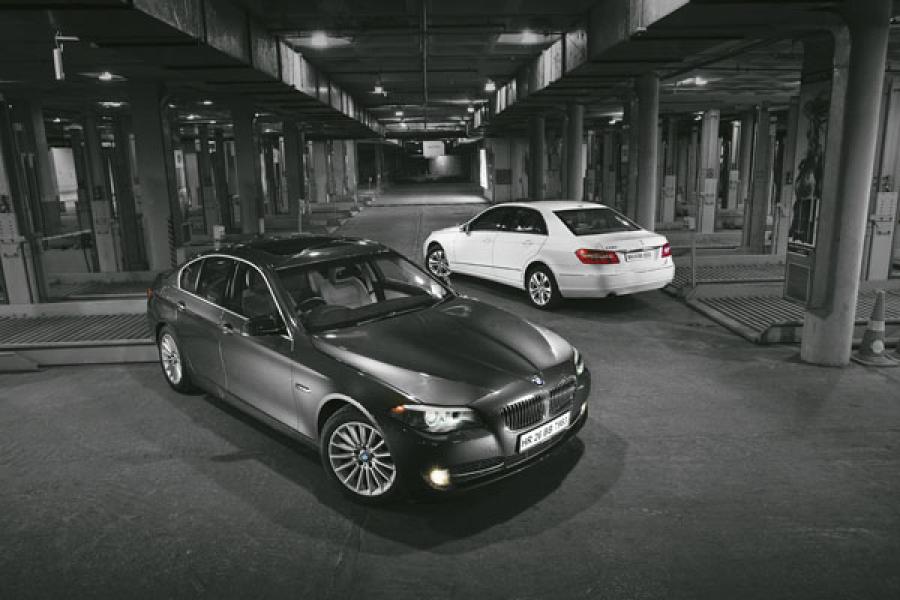
BMW or Mercedes - Which One Should You Buy?
More like shades of grey. With the E-Class taking on a sporty demeanour and the 5 Series pulling off an admirably comfortable ride, where to park your 50 lakh rupees has become a rather difficult question
Time was when this would have been a foregone conclusion: BMW would win on dynamic ability, Mercedes on comfort. But in the three years since BMW set up shop in India, it has passed a snoozing Mercedes-Benz.
The model that did the business was the 5 Series, which sold 3500 units in just under three years. On the other side: Though the new E had been launched in Europe nearly a year before, India was saddled with the old one. Everybody who could afford one either waited or bought BMWs. That should have been reversed this year, since there is usually a long gap before new models hit India. But, just two months after we drove the sixth-generation 5 Series (F10) at its world launch it’s here, ready to do battle.
DESIGN
If there’s an instant criticism of the new 5 Series, it’s that it has lost the design mojo that made BMW, well, BMW. The softening and toning down started with the 7 Series and the 5 opts drops all the in-your-face details for sophistication and light and shadows effects. You need an hour walking around it to absorb all the subtleties: tightly-pinched shoulder line running from front wheel arch to tail lamps stretching out the passenger cell, ever-so-slightly concave sides, pumped out wheel arches, deep creases in the bonnet, the short front overhang, the pert bum that stretches over the rear wheels. From the 7 Series come details like the wider, more upright grille (in profile seeming to be leaning forward) and the L-shaped tail lamps with three rows of LEDs. The 7’s heavily detailed head lamps with the iced eyebrows and LED corona-ring daytime running lamps are re-interpreted here. That sets the tone for a car that grows on you, that looks much calmer than its predecessor, more compact, despite having grown.
Which is in marked contrast to the E-Class, where Mercedes has ditched conservatism for a more prominent three-box profile, squared off lines, angular, sharp creases, prominent shoulder lines, interesting wheel arch treatment from the ’53 Ponton Benz and lots of bright-work. It is also the slipperiest four-door saloon in the world, with a drag coefficient of just 0.26 Cd. It is both stylish and elegant and has the potential to look sporty too. This a big luxury saloon that makes no bones about it. Except for rear tail lamps (that could have come from Japan or Korea), Merc has elegant opulence.
INTERIORS
If you’ve sat in a 7 Series, you will be instantly familiar with the 5’s cabin. The trickle-down has really helped; quality (never a complaint) is even better, the materials plusher, the plastics softer, the wood trim very posh and, ah, the aroma of leather. It’s not as driver-focused as before but it doesn’t snub the front passenger either and is probably a better balance. Sporty details abound: Speedo and tacho dials get equal prominence, unencumbered by integrated displays; the steering has thicker hand-holds and a sporty diameter; the gear lever is a handful of metal, not the size-zero lever of the earlier 5.
Upholstery options are black, beige, brown/black, oyster/oyster dark, or oyster/black. Whatever you choose, you get fabulous seats that support and pamper you in the right places. The cabin is isolated from wind and tyre noise, unlike the E which has significant tyre noise intrusion.
Heightened focus on safety is the norm in this segment; there are front, side and head air bags for driver and passengers, rear curtain air bags, and a pop-up bonnet that cushions the blow to pedestrians on impact. Though it is too new to be crash-tested, there’s little doubt it will get five stars in the EuroNCAP ratings.
The E-Class has a full five-star crash safety rating, with all this plus knee air bags, and Attention Assist (which monitors your driving; when it senses you’re falling asleep it flashes a warning).
Inside, the E-Class gets more brightwork, and quality is up there with the best. But while the 5 Series feels like a scaled down 7 Series, the over-riding impression of the E is of being a scaled up C-Class.
Our test car had full black interiors; brown and beige, also on offer, makes the cabin look classier and more airy.
Merc’s COMAND system is easier to use than BMW’s iDrive but has less functionality and a smaller screen. The Merc’s gear lever is mounted on the steering column, liberating space for much larger cup-holders than the BMW’s, and more cubby holes. Though the BMW has a larger wheelbase, the Merc has a few extra millimetres of rear seat space. However the front seats, while ample, don’t have as much side support and you tend to slide in the seats while driving hard.
CHASSIS & SUSPENSION
The new F10 uses a conventional steel monocoque with steel springs; to keep weight and balance in check, bonnet, front wings, doors and some suspension components are aluminium. The basic chassis is essentially the same as the 7 Series, with the wheelbase scaled down by 100mm (at 2986mm it’s still the longest in this class) and the suspension set-up is similar. Instead of hydraulics, the power steering is electrically assisted, for better fuel efficiency. The 7 Series platform also allows the 5 Series to get technology never before seen on this class, and the 535i is the all-singing all-dancing range topper, the only one with four-wheel-steering and dynamic damping control (DDC). With four-wheel-steering, at low speeds the rear wheels point in the opposite direction to the front wheels to reduce the turning circle; at high speed all wheels point in the same direction for stability.
 The E-Class also uses a steel monocoque with aluminium bonnet, front wings and boot lid. While not at the cutting edge like BMW’s DDC, the self-adjusting dampers (adapted from the C-Class) work well, blending accurate handling with a supple ride. The steering is fully hydraulic with a variable ratio that reduces the amount of steering lock required at city speeds by almost 15 percent. Unlike the 5 Series, where you can switch off ESP, the E-Class’s electronic nanny only allows a little leeway before cutting in.
The E-Class also uses a steel monocoque with aluminium bonnet, front wings and boot lid. While not at the cutting edge like BMW’s DDC, the self-adjusting dampers (adapted from the C-Class) work well, blending accurate handling with a supple ride. The steering is fully hydraulic with a variable ratio that reduces the amount of steering lock required at city speeds by almost 15 percent. Unlike the 5 Series, where you can switch off ESP, the E-Class’s electronic nanny only allows a little leeway before cutting in. DYNAMICS
On the 5 Series, the doors no longer need effort. Next most obvious: The lack of steering effort. Most importantly, ride quality has dramatically improved; even on the 18-inch alloys on the 535i, comfort has significantly improved, and now it rides like a luxury saloon should with none of the constant jiggling and bobbing over average roads that characterised the outgoing model. Thunks and thuds from the suspension are better isolated. Lesser variants get 17-inch alloys with higher profile tyres; if you can bear the look I would recommend that: ride quality will be significantly better. This quest for improved ride quality hasn’t sacrificed dynamic edge. It does roll a bit more than the older car and over an absolutely smooth, flat corner there seems to be a little more understeer. In the real world and on our favourite mountain test route, Sport mode weights up the steering nicely; the suspension stiffens but retains a degree of compliance, permitting the dampers to soak in bumps in a corner, making it faster up a winding road.
The perception is of Mercs being soft cars for backseat drivers; this E is anything but. There are significant differences. While the BMW wraps itself around the driver, you feel like you’re sitting on top of the Merc. The steering wheel is too large and the half-wood trim is not good for sporty driving. The seats are flat and lack support while the brakes don’t feel as sharp as the BMW’s (though it gives nothing away in absolute retardation). So you approach a corner, brake a little early, take things easy. But turn in and it displays surprising eagerness, bite and enthusiasm. So you go faster and faster and corner after corner is tackled with spirit. There is a bit more body roll than the BMW but bite from the front is very good and the steering has great feedback and communication. This E can be hustled and the driver will enjoy hustling her. But back off and Merc’s traditional luxury is dished out in spades. The E-Class cabin still lays the marker as far as road isolation, disconnection from potholes and sheer comfort go.
VERDICT
In terms of dynamics, the BMW still sets the bar; but it’s now so close that you need a challenging track and some committed driving for the differences to show up. And while the E-Class wins on comfort, BMW has narrowed the gap to almost nothing. It’s still (if only just about): if you prioritise comfort take the E, if you want fun, take the 5. But we have to choose a winner and pricing will help us decide. The 535i, at Rs. 58 lakh, is Rs. 13 lakh more than the E350. Though the extra cash gets you the fastest, most involving car in this segment, the appeal will be limited to a few enthusiasts. At the bottom of the range, it’s Rs. 38.9 lakh for the 523i versus Rs. 42.88 lakh for the E250. But the comparison that really matters is between the 530d at Rs. 45.9 lakh and E350 CDI at Rs. 49 lakh. That brings closure.
It’s not just that the 5 Series is cheaper despite more goodies; its phenomenal breadth of abilities mated to perfectly judged blend of ride and dynamism has it just about nudging ahead.
The writer is Editor, Overdrive. Read a longer version at overdrive.in
(This story appears in the 13 August, 2010 issue of Forbes India. To visit our Archives, click here.)















